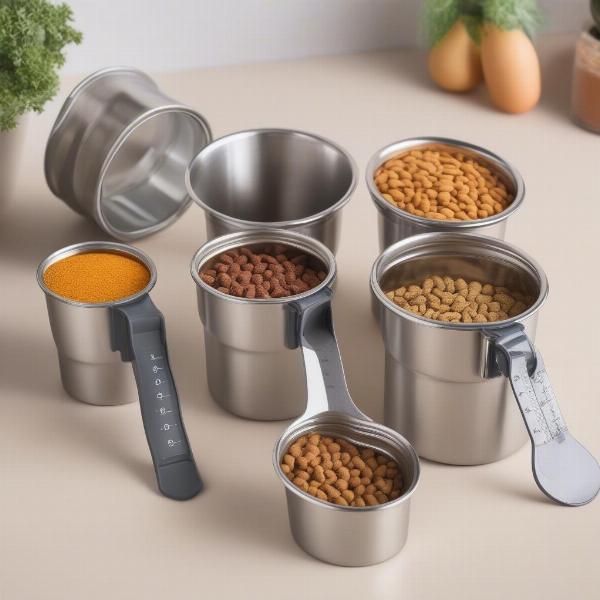Knowing how much to feed your dog is crucial for their health and well-being. A dog food cup isn’t just a scoop; it’s a tool for portion control, preventing overfeeding or underfeeding. The right dog food cup can help you maintain your dog’s ideal weight, ensuring they receive the proper nutrients for a long, happy life. This guide will explore everything you need to know about choosing and using a dog food cup, from understanding different types to accurate measurement techniques.
Types of Dog Food Cups and Their Benefits
Choosing the right dog food cup can seem simple, but there’s more to it than you might think. Various types cater to different needs and preferences.
- Standard Measuring Cups: These are readily available in most kitchens and come in various sizes (1 cup, 1/2 cup, 1/4 cup, etc.). They’re a cost-effective option for measuring kibble.
- Collapsible Cups: Ideal for travel or storage, these cups fold down for easy portability. Perfect for dog owners on the go.
- Digital Scales: While not a cup, scales offer the most accurate way to measure dog food, especially for those following strict dietary guidelines. They measure by weight, eliminating the variations in volume that can occur with cups.
- Scoops with Built-in Scales: Combining the convenience of a scoop with the precision of a scale, these are a great option for precise portioning.
 Types of Dog Food Cups: Standard, Collapsible, and with Built-in Scales
Types of Dog Food Cups: Standard, Collapsible, and with Built-in Scales
How to Accurately Measure Dog Food Using a Cup
Using a dog food cup correctly is vital for consistent portioning. Here’s a step-by-step guide:
- Select the right cup size: Choose a cup that corresponds to your dog’s daily food requirement.
- Level the food: Avoid scooping directly from the bag, which can lead to compacting and inaccurate measurements. Pour the kibble into the cup gently.
- Use a straight edge: Level the top of the cup with a knife or a flat object to ensure a precise measurement. Don’t pack the food down.
Why Accurate Measurement Matters
Accurate measurement is essential for your dog’s overall health. Overfeeding can lead to obesity, while underfeeding can result in nutritional deficiencies.
- Maintaining Ideal Weight: Precise portioning helps prevent weight-related issues, such as joint problems and diabetes.
- Nutrient Balance: Ensuring the correct amount of food means your dog receives the appropriate balance of vitamins and minerals.
- Dietary Management: For dogs with specific dietary needs, accurate measurement is critical for managing their condition.
“Precise measurement is the cornerstone of proper canine nutrition,” says Dr. Emily Carter, DVM, a renowned veterinary nutritionist. “It’s not just about how much you feed, but how consistently you measure that amount.”
Factors Influencing Food Portion Size
Several factors influence how much food your dog needs.
- Age: Puppies require more frequent and smaller meals than adult dogs. Senior dogs may need adjustments based on their activity level and metabolism.
- Breed: Larger breeds generally require more food than smaller breeds.
- Activity Level: Highly active dogs need more calories than those with a more sedentary lifestyle.
- Health Conditions: Certain medical conditions may necessitate dietary adjustments.
Conclusion
Choosing the right dog food cup and using it correctly is a fundamental aspect of responsible dog ownership. By understanding the different types of cups available, mastering accurate measuring techniques, and considering the factors that influence portion size, you can ensure your dog receives the optimal nutrition they need to thrive. A simple dog food cup can make a significant difference in your dog’s overall health and well-being.
FAQs
- Q: What if I don’t have a dog food cup? A: You can use a standard kitchen measuring cup as a temporary solution. However, investing in a dedicated dog food cup or scale is recommended for long-term accuracy.
- Q: How often should I adjust my dog’s food portion? A: Regularly monitor your dog’s weight and body condition. Consult your veterinarian for guidance on adjusting portions as needed, especially during growth stages or if health conditions arise.
- Q: Can I use the same dog food cup for different types of kibble? A: Yes, as long as you are measuring by volume. However, the weight of different kibble can vary, so using a scale is ideal for precise portioning, especially when switching between brands.
- Q: My dog seems hungry even after I’ve fed them the recommended amount. What should I do? A: Consult your veterinarian to rule out any underlying medical conditions. They can also help assess your dog’s ideal weight and adjust the food portion if necessary. You might also consider adding healthy, low-calorie treats to their diet.
- Q: Is it okay to mix wet and dry food in the same cup? A: It’s best to measure wet and dry food separately to ensure accurate portioning. The densities of the two food types are different, which can affect the overall measurement.
Related Articles
- dog food measuring cup
- dog food scoop 1 cup
- how many cups in 30 pounds of dog food
- how many cups in 30lb bag of dog food
ILM Dog is your trusted resource for expert advice on dog breeds, health, training, nutrition, grooming, and much more. We provide comprehensive and practical information for dog owners worldwide, covering everything from puppy care to senior dog care, and even tips for traveling with your furry friend. We’re passionate about helping you provide the best possible care for your canine companion. Contact us for personalized guidance on dog nutrition and dietary management: Email: [email protected], Phone: +44 20-3965-8624. Connect with ILM Dog today!